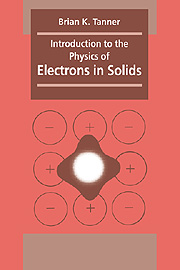Book contents
- Frontmatter
- Contents
- Preface
- Acknowledgements
- 1 The classical free electron model
- 2 Quantum mechanical free electron model
- 3 Application of the Fermi gas model
- 4 Energy bands
- 5 Experimental evidence for band structure and effective mass
- 6 Electrical conduction in semiconductors and insulators
- 7 Semiconductor devices
- 8 Localized electrons
- 9 Magnetism
- 10 Superconductivity
- Appendix 1 Elements of kinetic theory
- Appendix 2 Elements of statistical mechanics
- Appendix 3 Derivation of the Landé g factor
- Index
7 - Semiconductor devices
Published online by Cambridge University Press: 05 June 2012
- Frontmatter
- Contents
- Preface
- Acknowledgements
- 1 The classical free electron model
- 2 Quantum mechanical free electron model
- 3 Application of the Fermi gas model
- 4 Energy bands
- 5 Experimental evidence for band structure and effective mass
- 6 Electrical conduction in semiconductors and insulators
- 7 Semiconductor devices
- 8 Localized electrons
- 9 Magnetism
- 10 Superconductivity
- Appendix 1 Elements of kinetic theory
- Appendix 2 Elements of statistical mechanics
- Appendix 3 Derivation of the Landé g factor
- Index
Summary
One of the most remarkable developments of the last decade has been the growth of the semiconductor industry. The exploitation of the properties of semiconducting materials to build large logic arrays on a single piece of crystal has led to a dramatic increase in the processing power and memory capacity of small computers, with a simultaneous fall in price. Development of single chip microprocessors has revolutionized our mode of working in a whole range of fields from the factory floor to the office. In this chapter we will examine the basic physics associated with a number of devices, and as many devices rely on the properties of junctions between n- and p-type semiconductors a fairly detailed discussion of such junctions is given before individual devices are treated. However, because all devices require connection to metallic wires in order to join components together we will first examine the metal–semiconductor junction. As it turns out this proves to be an excellent introduction to the p–n junction as well as providing a glimpse into some of the not-so-obvious pitfalls associated with device manufacture.
Metal–semiconductor junctions
The Schottky barrier
Let us suppose that a piece of metal is brought into contact with a piece of n-type semiconductor. (Of course, in practice, the metal would be evaporated on the semiconductor as a thin film, or attached with a soldered connection in which an alloy is formed, but such a naive picture is useful to fix our ideas.)
- Type
- Chapter
- Information
- Introduction to the Physics of Electrons in Solids , pp. 138 - 165Publisher: Cambridge University PressPrint publication year: 1995



